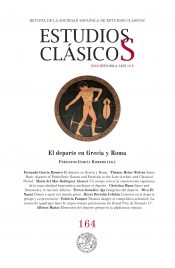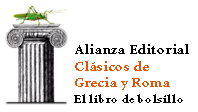Some Basic Aspects of Panhellenic Games and Festivals in the Late-Archaic and Classical PeriodSome Basic Aspects of Panhellenic Games and Festivals in the Late-Archaic and Classical Period
Thomas Heine Nielsen
Resumen
This essay deals with the meaning of the term ‘panhellenic’ in its use in a sporting context, considering why the term is reserved in modern scholarship to designate the four great sporting festivals of ancient Greece (Olympian, Pythian, Isthmian and Nemean Games). It is an inescapable conclusion that the basic characteristics of the Panhellenic athletic festivals (their inclusion as spectacles into religious festivals, their acceptance of all comers, the events program, the complex competitions announcement system) are not exclusive to these four festivals but shared with numerous other festivals. So, the Panhellenic festivals were simply the most conspicuous examples of a rather common Greek institution, the athletic festival. The crowds that attended the Games, and the ambitions and motivations of the athletes when participating are also considered.
Palabras clave: Juegos Panhelénicos; Grecia arcaica y clásica; espectadores; atletas
Abstract
El artículo se ocupa del sentido del término ‘panhelénico’ en su uso en contextos deportivos, discutiéndose específicamente por qué los estudiosos modernos reservan el término para designar los cuatro grandes festivales deportivos de la antigua Grecia (Juegos Olímpicos, Píticos, Ístmicos y Nemeos). Es indiscutible que las características esenciales de los festivales deportivos panhelénicos (su inclusión como espectáculo en festivales religiosos, el hecho de que pudieran participar griegos de cualquier procedencia, el programa de pruebas, el complejo sistema de anuncio de las competiciones) no son exclusivas de esos cuatro grandes juegos, sino compartidas con otros muchos festivales. Los Juegos Panhelénicos eran simplemente los más sobresalientes ejemplos de una institución griega común, el festival deportivo. Se estudian también aspectos relativos a las multitudes que se congregaban para asistir a los juegos y las ambiciones y objetivos de los atletas para participar.
Keywords: Panhellenic Games; archaic and classical Greece; spectators; athletes
Referencias bibliográficas
Bosworth, A. B. (1988) Conquest and Empire. The Reign of Alexander the Great, Cambridge: Cambridge University Press.
Bowra, C. M. (1938) «Xenophanes and the Olympic Games», The American Journal of Philology 59: 257–279.
Bury, J. B. (1892) The Isthmian Odes of Pindar, London: Macmillan (reprinted by Hakkert, Amsterdam 1965).
Carne-Ross, D. S. (1985) Pindar, New Haven & London: Yale University Press.
Christesen, P. (2007) Olympic Victor Lists and Ancient Greek History, Cambridge: Cambridge University Press.
Christesen, P. (010) «Whence 776? The Origin of the Date for the First Olympiad», in Z. Papakonstantinou (ed.), Sport in the Cultures of the Ancient World, London-New York: Routledge, 13–34.
Cook, B. F. (1987) Greek Inscriptions, London: British Museum Press.
Crowther, N. B. (1991) «The Olympic Training Period», Nikephoros 4: 161–166
Crowther, N. B. (1996) «Athlete and State: Qualifying for the Olympic Games in Ancient Greece», Journal of Sport History 23: 34–43.
Ebert, J. (1972) Griechische Epigramme auf Sieger an gymnischen und hippischen Agonen, Berlin: Akademie-Verlag.
Farrington, A. (2012) Isthmionikai. A Catalogue of Isthmian Victors, Hildesheim: Weidmann.
Flower, M. (2000) «From Simonides to Isocrates: The Fifth-Century Origins of Fourth-Century Panhellenism», Classical Antiquity 19: 65–101.
Funke, P. (2005) «Die Nabel der Welt. Überlegungen zur Kanonisierung der ‘panhellenischen’ Heiligtümer», in T. Schmitt et al. (eds.) Gegenwärtigen Antike – antike Gegenwarten, München: Oldenbourg Wissenschaftsverlag, 1–16.
Golden, M. (1998) Sport and Society in Ancient Greece, Cambridge: Cambridge University Press.
Hornblower, S. (2004) Thucydides and Pindar. Historical Narrative in the World of Epinikian Poetry, Oxford: Oxford University Press.
Jebb, R. C. (1905) Bacchylides. The Poems and Fragments, Cambridge: Cambridge University Press.
Keesling, C. M. (2017) Early Greek Portraiture. Monuments and Histories, Cambridge: Cambridge University Press.
Kokolakis, M. (1992) «Intellectual Activity on the Fringes of the Games», in W. Coulson & H. Kyrieleis (eds.), Proceedings of an International Symposium on the Olympic Games, Athens: Deutsches Archäologisches Institut,153-158.
Kostourou, G. P. (2008) Νεμέων ἄθλων διήγησις. B. «Νεμεᾶται». 286 Νεμεονῖκες της Αρχαιότητας, Nemea: Personal Press.
Kyle, D. G. (1993) Athletics in Ancient Athens2, Leiden: Brill.
Kyle, D. G. (1996) «Gifts and Glory: Panathenaic and Other Greek Athletic Prizes», in J.Neils (ed.), Worshipping Athena. Panathenaia and Parthenon, Madison: University of Wisconsin Press, 106–136.
Lämmer, M. (2010) «The So-called Olympic Peace in Ancient Greece», in J. König (ed.), Greek Athletics, Edinburgh: Edinburgh University Press.
Lee, H. M. (2001) The Program and Schedule of the Ancient Olympic Games, Hildesheim: Weidmann.
Mann, C. (1998) «Krieg, Sport und Adelskultur. Zur Entstehung des griechischen Gymnasions», Klio 80: 7–21.
Markovich, M. (1978) «Xenophanes on Drinking Parties and Olympic Games», ICS 3: 1–26.
McDevitt, A. (2009) Bacchylides. The Victory Poems, London: Bristol Classical Press.
Miller, S. G. (2004) Ancient Greek Athletics, New Haven-London: Yale University Press.
Miller, S. G. et al. (2004) Nemea. A Guide to the Site and Museum, Athens: Ministry of Culture.
Mitchell, L. (2007) Panhellenism and the Barbarian in Archaic and Classical Greece, Swansea: Classical Press of Wales.
Moretti, L. (1953) Iscrizioni agonistiche Greche, Roma: Angelo Signorelli Editore.
Moretti, L. (1957) Olympionikai, i vincitori negli antichi agoni olimpici, Roma: Academia Nazionale dei Lincei.
Neumann-Hartmann, A (2007) «Das Wettkampfprogramm der panhellenischen Spiele im 5. Jh. v. Chr.», Nikephoros 20: 113–151.
Neumann-Hartmann, A (2008) «Prosopographie zu den Epinikien von Pindar und Bacchylides», Nikephoros 21: 81–131.
Nicholson, N. (2021) «Greek Hippic Contests», in A. Futrell & T.F. Scanlon (eds.), The Oxford Handbook of Sport and Spectacle in the Ancient World, Oxford: Oxford University Press, 242–253.
Nielsen, T. H. (2007) Olympia and the Classical Hellenic City-State Culture, Copenhagen: The Royal Danish Academy of Sciences and Letters.
Nielsen, T. H. (2013) «Can ‘Federal Sanctuaries’ Be Identified in Triphylia and Arkadia?», in F. Punke & M. Haake (eds.), Greek Federal States and Their Sanctuaries. Identity and Integration, Stuttgart: Franz Steiner Verlag, 227–244.
Nielsen, T. H. (2014) [2019] «Foreign entrants at minor athletic festivals in late-Archaic and Classica Greece», Nikephoros 27: 91–158.
Nielsen, T. H. (2018) Two Studies in the History of Ancient Greek Athletics, Copenhagen: The Royal Danish Academy of Sciences and Letters.
Nielsen, T. H. (2023) «A Note on the Number of Events in Classical Greek Athletics», Nikephoros 29: 215–223.
Nielsen, T. H. (forthcoming) «On the Pursuit of Athletic Glory by the Poleis of Late-archaic and Classical Greece», to appear in the proceedings of the 2022 Mannheim conference «Money and Honor in Greek Athletics», edited by C. Mann et al.
Papakonstantinou, Z. (2002) «Prizes in Early Greek Sport», Nikephoros 15: 51–67.
Perlman, P. (2000) City and Sanctuary in Ancient Greece. The Theorodokia in the Peloponnese, Göttingen: Vandenhoeck & Ruprecht.
Poliakoff, M. B. (2021) «Greek Combat Sport and the Borders of Athletics, Violence, and Civilization», in A. Futrell & T.F. Scanlon (eds.), The Oxford Handbook of Sport and Spectacle in the Ancient World, Oxford: Oxford University Press, 221–231.
Pritchard, D. M. (2013) Sport, Democracy and War in Classical Athens, Cambridge: Cambridge University Press.
Race, W. H. (1997) Pindar. Nemean Odes. Isthmian Odes. Fragments, Cambridge (MA)-London: Harvard University Press.
Remijsen, S. (2011) «The So-Called ‘Crown-Games’: Terminology and Historical Context of the Ancient Categories for Agones», ZPE 177: 97–109.
Remijsen, S. (2015) The End of Greek Athletics in Late Antiquity, Cambridge: Cambridge University Press.
Richardson, N. J. 1992. «Panhellenic Cults and Panhellenic Poets», CAH 52: 223–244.
Romano, D. G. (2021) «Greek Footraces and Field Events», in A. Futrell & T.F. Scanlon (eds.), The Oxford Handbook of Sport and Spectacle in the Ancient World, Oxford: Oxford University Press, 209–220.
Roy, J. (2013) «Olympia, Identity and Integration: Elis, Eleia, and Hellas», in F. Punke & M. Haake (eds.), Greek Federal States and Their Sanctuaries. Identity and Integration, Stuttgart: Franz Steiner Verlag, 107–121.
Rutherford, R. (2005) Classical Literature. A Concise History, Malden: Blackwell Publishing.
Rutherford, I. (2013) State Pilgrims and Sacred Observers in Ancient Greece. A Study of Theōriā and Theōroi, Cambridge: Cambridge University Press.
Scanlon, T. F. (2002) Eros and Greek Athletics, Oxford: Oxford University Press.
Shear, J. L. (2021) Serving Athena. The Festival of the Panathenaia and the Construction of Athenian Identities, Cambridge: Cambridge University Press.
Shipley, G. (1987) A History of Samos 800–188 BC, Oxford: Clarendon Press.
Sider, D. (2020) Simonides. Epigrams & Elegies, Oxford: Oxford University Press.
Smith, R. R. R. (2007) «Pindar, Athletes, and the Early Greek Statue Habit», in S. Hornblower & C. Morgan (eds.), Pindar’s Poetry, Patrons, and Festivals. From Archaic Greece to the Roman Empire, Oxford: Oxford University Press, 83–139
Strasser, J.-Y. (2001) Πυθιονῖκαι. Recherches sur les vainqueurs aux Pythia de Delphes. Tome 1, Paris: L’Académie des Inscriptions et Belles-Lettres.
Theotikou, M. (2013) Die Ekecheiria zwischen Religion und Politik. Der sog. «Gottesfriede» als Instrument in den zwischenstaalichen Beziehungen der griechischen Welt, Berlin: Lit Verlag.
Thomas, R. (2012) «Pindar’s ‘Difficulty’ and the Performance of Epinician Poetry. Some Suggestions from Ethnography», in P. Agócs et al. (eds.), Reading the Victory Ode, Cambridge: Cambridge University Press, 224–245.
Verity, A. (2007) Pindar. The Complete Odes. A New Translation, Oxford: Oxford University Press.
Willcock, M. M. (1995) Pindar. Victory Odes. Olympians 2, 7 and 11, Nemean 4, Isthmians 3, 4 and 7, Cambridge: Cambridge University Press.
Willis, W. H. (1941) «Athletic Contests in the Epic», TAPA 72: 392–417.
Wolicki, A. (2002) «The Heralds and the Games in Archaic and Classical Greece», Nikephoros 15: 69–97.
Revista
-
Sobre la revista
Página principal
-
Estatutos
Estatutos de la Revista Estudios Clásicos
-
Código ético
Declaración de buenas prácticas
-
Normas de recepción y envío
Indicaciones para envíos de artículos
-
Equipo editorial
Consejos de redacción y asesor
-
Comité de honor
Comité de honor
Información
-
Para autores
Publicar con nosotros
-
Para evaluadores
Normas para evaluar artículos
-
Para bibliotecas
Información bibliográfica
-
Contacto
Cuestiones y preguntas
Publicar en EClás
-
Envío de originales
Artículos y reseñas
-
Normas de publicación
Descarga normas en PDF
-
Estilo CSL EClás
Estilo CSL EClás
-
Índices de calidad
Bases de datos e impactos


 c/ Serrano, 107
c/ Serrano, 107